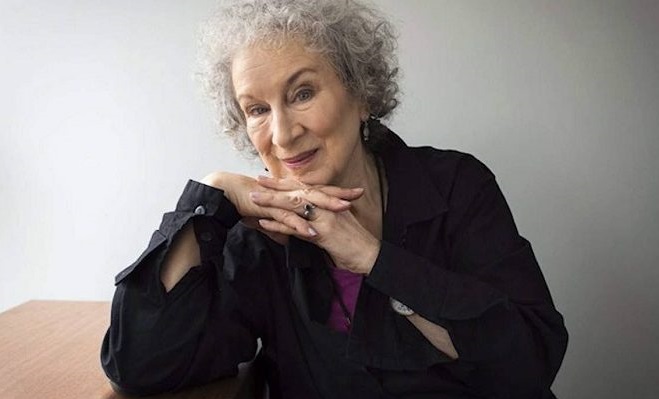Margaret Atwood Net Worth 2025 + Bio, Age, Height
Margaret Atwood is one of Canada’s most important novelists and poets. Born in Ottawa in 1939, she has written about fifteen novels, as many collections of poetry and a dozen news, essays and children’s books.
Already known in the 1970s, she returned to the front of the stage in 2017 through the series The Scarlet Servant (The Handmaid’s Tale), adapted from his homonymous novel of 1985.
Early Life
Margaret Eleanor Atwood was born November 18, 1939 into a Protestant family in Ontario, Canada. Daughter of a nutritionist and an entomologist, she spent her childhood in Grimm’s tales and the Canadian forests. Endowed with an overflowing imagination, she already writes poems at 6 years old.
In 1962, Margaret graduated from the University of Toronto with a Bachelor of Arts and went on to study at Harvard until 1967. In the meantime, she wrote her first collection of poems, Double Persephone, for which she won the EJ Pratt Medal of poetry.
While teaching English at several universities, she continues to write and publish The Circle Game, another poetry collection hailed for the Governor General’s Award, and her first novel, The Edible Woman).
After a first marriage with American journalist Jim Polk from 1968 to 1973, she married the Canadian novelist Graeme Gibson, with whom she had 3 children. At that time, Margaret Atwood worked as an editor for House of Anansi Press and as a cartoonist and editor for This Magazine.
In 1972, she wrote an essay that completely changed Canadians’ view of their literature. Survival: A Thematic Guide to Canadian Literature is quickly added to the curriculum. It was also that year that she had her first big hit with her second novel, surfacing.
In 1985, she finally published the novel that will make it known worldwide, The Handmaid’s Tale. Since then, she has written about thirty other works, varying between prose and poetry. She currently lives in Toronto with Graeme Gibson.
Appointed vice-president of the Writer’s Union of Canada in 1980, Margaret Atwood fought for several years against literary censorship.
Adept of the anticipation novel, Margaret Atwood often portrays futuristic pessimistic and terrifying universes. This is the case of The Scarlet Servant, but also Oryx and Crake (The Last Man) and his latest novel The Heart Goes Last (It’s the heart that lets go last). With inventive language and great writing power, she breaks the traditional boundaries between fiction and poetry.
If she does not call herself a feminist, the author defends the feminine cause by regularly addressing the alienation of women and their role in society. She also speaks a lot about environmental degradation, power dynamics, civil liberties, including in Bodily Harm, and relationships between men and women, as in The Robber Bride).
Margaret Atwood also uses her sharp pen to revisit certain myths, such as the fairy tales in Lady Oracle or the Odyssey in The Penelopiad (The Penelope Odyssey).
Career Path
Regularly nominated for the Nobel Prize for Literature, Margaret Atwood has accumulated awards during her career.
Hailed from the outset with the Governor General’s Award, she received, among others, the Arthur C. Clarke Science Fiction Award for The Handmaid’s Tale in 1985, the Giller Award for Captive in 1996 and the Booker Prize for The Blind Assassin (The Blind Slayer) in 2000.
All of his work was awarded in 2007 by the Blue Metropolis Grand Prize and 10 years later by the Franz-Kafka Award. A member of the Order of Canada, Margaret Atwood also received the Princess of Asturias Award in 2008. She is now one of the greatest writers in North America.
Atwood may have become known to the broader public through the filming of her 1985 novel, The Story of the Servant, an oppressive vision of a society ruled by a patriarchal-bigot power elite. This “vision” has lost nothing of global relevance and political explosiveness.
Atwood writes essays, reviews, poetry, short stories, children’s books and novels published in over 40 languages and is one of the most successful and influential Canadian authors.
Critics say, one of the most widely read English-speaking authors of all, i.e. because in her works she brings societal and political questions into different “readable and understandable” literary forms. Atwood also combines the profiling of a distinctive identity-forming Canadian (as opposed to US) literature.
Margaret Atwood was born on November 18, 1939, in Ottawa, Canada, where her father Carl Edmund Atwood worked as an entomologist and taught her mother at home in the early years due to the remote location of her abode Atwood and her elder brother Harold.
Her parents describe Atwood as being relatively unconventional, which gave her development opportunities and (creative) open spaces that were extraordinary for girls at the time.
When she was seven, her father received a biology professorship, and the family moved from the Canadian forests to Toronto, where her sister Ruth was born in 1951.
Atwood studied English language and literature and received her bachelor’s degree in 1961 in Toronto. Atwood’s first reviews and articles appeared in her college newspaper, and she self-published her first book of poetry, Double Persephone, sold for 50 cents and traded for well over $ 1,000, according to Atwood.
With wonderful irony she describes her literary development: her initial “backwater naivety,” her uncertainty in urban surroundings, the then almost obligatory black turtleneck pullovers, candles in Chianti bottles, canned food and worked-through nights. But also the growing public recognition as well as she increasing self-confidence as a writer.
In an interview, in retrospect, and not without sarcastic realism, she said that in the late fifties / early sixties there were just five desirable professions for women: secretary, housekeeper, nurse, teacher, and stewardess.
At this time, the “second North American women’s movement” was emerging: Betty Friedan’s “Feminine Mania” appeared in 1963 and coined Atwood’s thinking and writing as a feminist, along with Simone de Beauvoir’s The Other Gender, as a political writer in the tradition of Orwell (“1984”) and Huxley (“Beautiful New World”) sees.
In 1962, she received her master’s degree from the prestigious Radcliffe College, Massachusetts, USA; her subsequent dissertation left her unfinished. To secure his livelihood followed teaching in Canada, the USA, England and Australia.
Since the late 1970s, Atwood has lived with writer Graeme Gibson, the father of her 1976-born daughter Eleanor Jess Atwood Gibson. Since 1992 they live in Toronto.
Personal life
Margaret Eleanor Atwood was born in Ottawa, Canada on November 18, 1939 and is the second child of a Protestant family. She spends much of her time in the forests of Ontario in northern Quebec with her father, a renowned entomologist. Nourished in Grimm’s tales, she wrote her first poems at the age of six.
While finishing her English studies at the University of Toronto in 1964, she won with her first book “Circle Game” a collection of poems, the Canadian EJ Pratt Medal Poetry. Five years later, her second novel, “The Edible Woman” while writing as a student at Harvard is finally released because the publisher had claimed to have misplaced the manuscript sent four years earlier.
In 1978 an oedipal polar worthy of Hitchcock: “To surface” is worth to the writer a success of esteem. An influential member of the Union of Canadian Writers, Atwood is nicknamed “The New Sagan” or “The Snow Sagan” according to some journalists.
In 1998 she separated from the father of her three children the writer Graeme Gibson. She is an active supporter of the Canadian feminist movement and is nicknamed the MLF Antigone because of her almost man less universes and heralding color by challenging established society and displaying her immoderate taste for mythology, high literature, facts diverse and intricately constructed intrigues.
After more than 35 poems, essays, novels and novels translated in about fifty languages, in 2000, a little over 60 years old, the “great lady of Canadian letters” is four times nominated for her novel “The Blind Killer” and finally wins the prestigious Booker Prize.
The book is a huge commercial success in the United States where it sells over a million copies. This overflowing book is between a family saga in Canadian society since 1870 and a fantasy tale in a surrealistic, apocalyptic and destructive totalitarian world.
Her growing popularity as a writer enables Atwood to focus increasingly on writing and living from it. Atwood’s prose revolves around the complex interaction of the individual and society / community in very different historical power constellations.
She makes use of many literary genres (science fiction novel, historical novel, thriller, gothic novel) in which she portrays her female characters not as striking as “victims” but also as strong, multi-layered, partly obscure and torn personalities.
The outcome of their stories often remains open. It is also unclear to what extent her short stories in “Moral Disorder” are autobiographical. She deliberately plays with the fact that writers are always inventors in their own right.
She is currently critically examining social networks: “The other day I read that the CIA has this great new thing called Facebook. You do not have to spy anymore, people volunteer to tell you what they do and who their friends are «.
Quick summary
Full name: Margaret Eleanor Atwood
Date of birth: November 18, 1939
Birthplace: Ottawa, Ontario, Canada
Age: 80
Profession: Writer
Height: 1.63 m
Weight: 57 kg
Net Worth: 20$ million







